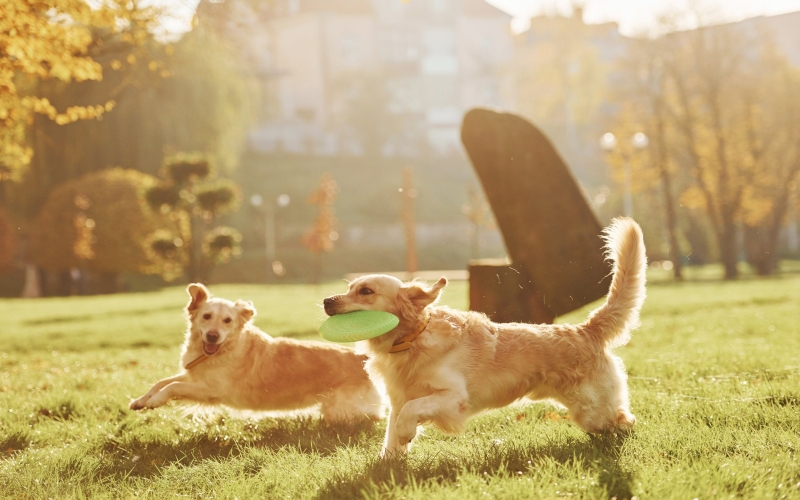
It’s that time of the year when your garden finally bursts into a cheerful smile with vibrantly hued flowers and foliage. The season promises longer, warmer days you have missed for so long. You and your pet doggy can be excited about the season that allows both to stay outdoors and wallow in the fresh air and sun. While nothing compares to the charm of springtime and outdoor fun, seasonal transitions require pet parents to pay more attention to their canines. Whether you spring clean your house, prepare your garden, or play with him on the lawn, prioritize your dog’s health to enjoy the goodness of the spring months. Here is a comprehensive guide to help you take cues and effortlessly maintain your pet’s well-being.
-
General springtime safety tips for dogs
In this atmosphere of fun and frolic, one has to be careful about indoor and outdoor pet hazards. Let’s start with indoor danger. Most homeowners plan to clean their houses in the spring using chemicals and other cleaning products. If you have a dog, please keep him away from diluted countertop cleaners and multipurpose sprays that can affect its stomach. Even condensed cleaners can cause serious health concerns like mouth and stomach ulcers. Pick your cleaning options carefully. Choose chemical solvents and paints that can be safe for your pet and you.
Similarly, lawn improvement can be your outdoor project and may again require using fertilizers, repellants, sprays, and chemicals. Preventing your furry friend from going there long after applying those products will be better. At the same time, other cleaning supplies, including rags and mop buckets, should be out of your dog’s reach.
Home and lawn improvement during spring is an age-old practice. However, keeping your pet safe is also essential. Soaps, polishes, cleaners, and bleach can irritate your pet’s skin and internal body functions. Even chewing sponges and others can be toxic for your curious canine. So, choose pet-safe items as much as possible. Unsafe cleaners should be stored far away. Also, the pet should be allowed to enter the cleaned area only after thoroughly drying it.
-
Lawn improvement tips for spring for pet’s safety
You can be eager to work on your garden and see it covered in bluebells, white hyacinths, and pink roses. All these flowers can perk up your lawn quickly. But do you know some flowers and plants are toxic for dogs? Many choices contain harmful elements that can ruin your little friend’s health. Following safety tips for dogs in spring gardening is also essential. While many dogs eat carefully, puppies and curious ones are most vulnerable. Safer options can be sunflowers, snapdragons, camellias, and roses. However, flowers like daffodils, Azaleas, bluebells, lilies, tulips, and hyacinths are best to avoid.
-
Why avoid these flowers and plants?
You can find daffodils attractive for their ability to brighten your garden instantly with their cheerful color. But your dog can fall sick after chewing them. Vomiting and upset stomachs can make them weak and shaky. Likewise, Azaleas’ aesthetic appeal is hard to resist, especially in its complete bloom form. However, your dog can severely suffer if he ingests the flower. Breathing difficulty, vomiting, and nausea can afflict your pet. Homeowners like to add a bed of bluebells in their spring gardens for their beauty. Your nosey puppy can harm itself by ingesting these flowers. The glycoside content of the plant can cause lethargy, vomiting, disorientation, and diarrhea to them. Eating a lily plant can be linked with risks like stomach aches, vomiting, diarrhea, etc. You must visit the vet if he looks unwell due to ingesting a lily.
Tulip is another favorite plant, but you may want to let go of it or be careful with its location. Tulip bulbs are irresistible for their charismatic hues, shapes, and textures. These are planted during fall to bloom in the soothing, moist, and cool spring weather. Plus, they have an Easter connection. Many homes use them in seasonal decorations. Unfortunately, these flowers are toxic to your furry friend’s gastrointestinal tract and mouth. Ingesting these plants can cause diarrhea, vomiting, and drooling problems. If you want to incorporate them in your garden, choose a faraway location for your curious pet’s safety. As for hyacinths, these can disturb breathing and heart rate.
-
Springtime health risks for pets and prevention
The delightful season comes with a set of health challenges for your canines. Hence, it’s essential to learn about the deadly diseases. You need this knowledge to keep your dog healthy in the active season and offer necessary help when it is urgent.
1. Ticks and fleas
The tick threat will be high in warmer months. Ticks cause Lyme disease in pets. If your area is prone to tick infestation, please be careful about your dog’s health. These toxic parasites can make your pet ill by transferring viruses, bacteria, etc. The danger can lurk in the woodland and grassy fields where these organisms thrive. They cling to the dog’s skin and suck blood. Quickly removing them is essential. However, it’s also a tough job. Even a trace of the tick head left behind in the skin can become a source of infection. That’s why vets can be more reliable in these matters.
For prevention, you must clean your property of stagnant water bodies that serve as the breeding grounds for bugs. You can also apply organic insect repellants instead of chemical treatments. Work on your pet’s immunity to avoid this and other infections.
2. Spring Allergies
Animals are susceptible to seasonal changes and allergies. Some telltales include too much licking, scratching, and red eyes. Watch out for skin irritation and other signs to seek timely consultation with the vet. Dogs can develop watery eyes, sneezing, and itching due to pollens from weeds, grasses, and trees. Their allergy symptoms resemble humans if you’ve noticed. Red and irritated skin is the obvious sign. Plus, diarrhea and vomiting hint at an upset stomach. These problems occur when they ingest toxic elements. So, keep an eye on your pet for any hint of discomfort. Knowing about the risks of seasonal changes and implementing precautions can protect your furry companion from most health dangers and make their spring season pleasantly memorable.
3. Heartworm disease
Mosquito bites can lead to this potentially fatal disorder affecting your little furry’s lungs, heart, and blood vessels. They can suffer from organ damage, such as heart failure. On your vet’s advice, one of the best measures can be administering heartworm medications for prevention throughout the year. Avoid areas infested with mosquitoes, especially during their high activity time. Regular vet visits are also recommended to detect early signs of the illness and treat it.
4. Canine distemper
Vaccines may have reduced the incidence of this viral disease in canines, but outbreaks can still happen during spring due to active wildlife that quickly becomes a host for viruses. This ailment can hamper your pet’s nervous system, digestive tract, and breathing. The best prevention methods entail vaccination for this disease at an appropriate age, a safe distance from unvaccinated and wild animals, and regular health check-ups.
- Giardiasis
This disease can reach your dog through melting snow and rainfall, which promotes the growth of the Giardia parasite. If you want to keep your dog safe, keep him away from contaminated spring water sources. Carry drinking water for your pet all the time. Ensure your friend is away from streams, puddles, etc. Check with the vet if your dog shows any discomfort.
6. Bee sting
The severity of the bee bite can vary depending on the affected location. Suppose it has made your dog’s leg, paw, or other body part lightly swollen. After consulting a vet, you can treat it with OTC solutions. However, it can be worrisome if the pet has been stung on its face. He can develop allergic reactions. Get the vet’s help instantly.
-
Additional info: Keep your pet fresh in spring
Your dog will likely have plenty of outdoor time. That means it can get messy after a long walk. How do you tackle this while ensuring your pup is all fresh? When you enter the home, let the dog step on a clean towel kept for him at the door to prevent its muddy paws from leaving dirt marks on the floor. Some debris may choose to stick around. You can remove it with a vacuum attachment used for pet hair. It reduces the need for elbow grease that goes into scrubbing your pet’s paws. The mud clumps will be out and away quickly. Some pet parents buy waterproof boots for their canines to keep their paws safe and dry.
Please keep your pet smelling nice by regularly bathing him. A mild shampoo will minimize the risk of dryness and itching. Brushing their fur is also great because they enjoy rolling in grass and dirt outdoors. A few minutes of grooming can be enough.
You and your dog can go on long walks regularly in spring. While it can be the most enjoyable thing, the risk of losing your pet should not be discounted. You can address this common concern by installing or updating their microchips with essential details. It will help you get your pet back home hassle-free.
Source: Explore







